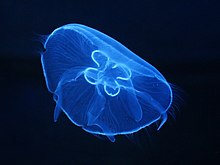Please tell me which books that present the scientific evidence FOR evolution you have studied in recent years? - Cofty
I have asked that question of lots of people who reject evolution. So far not one answer. I think I see a pattern.
Cofty, with all respect, two months ago you recommended Richard Dawkins' "The Ancestor's Tale" to me and I'm still struggling to find the facts, not the assumptions, regarding the question how jellyfish evolved into fish. It's over 500 pages and I tried to find real answers using the book's index. I came across jawless fish, jelly fish, sponges etc. and it appears to me the described "evolution" is in fact (modern) biology and anatomy of complete species that existed or still exist. That isn't evolution!
I mean, how, on a genetic level, do you turn a jellyfish...

...into these little fellows (early jawless fish)?


Lampreys (see picture below) are still living today and are supposed to be the very first jawless fish of the group hyperoartians, but (according to wiki) there is still uncertainty about its exact evolutionary relationship.

The lampreys are a very ancient lineage of vertebrates, though their exact relationship to hagfishes and jawed vertebrates is still a matter of dispute. [bold is mine]
It amazes me how you constantly speak of facts as presented in your own line of evidence, while Richard Dawkins' own book dares to speak in terms of "hint" and "speculation" (p.404,405, bold below is mine):
The 'sociable' behaviour of sponge
cells as exhibited by such experiments
perhaps sheds light on the normal
embryonic development of individual
sponges. Does it also give us some sort
of hint of how the first multicellular
animals (metazoans) evolved from
single-celled ancestors (protozoans)?
The metazoan body is often called a colony of cells. In keeping with this book's
pattern of using some tales as modern re-enactments of evolutionary happenings,
could the Sponge's Tale be telling us something about the remote
evolutionary past? Could the behaviour of the crawling and agglomerating cells
in Wilson's experiments represent some sort of re-enactment of how the first
sponge arose — as a colony of protozoans? Almost certainly it was not the same in detail. But here is a hint. The most
characteristic cells of sponges are the choanocytes, which they use for
generating currents of water. The picture on the opposite page shows a portion of
the wall of a sponge, with the inside of the cavity to the right. The choanocytes are
the cells that Une the cavity of the sponge. 'Choano-' comes from the Greek for
'funnel', and you can see the little funnels or collars, made up of many fine hairs
known as microvilli. Each choanocyte has a beating flagellum, which draws
water through the sponge, while the collar catches nutrient particles in the stream.
Take a good look at those choanocytes, for we shall meet something rather like them
at the next rendezvous. And then, in the hght of that, the following tale will
complete our speculation about the origin of multicellularity.
The book goes on to show pictures like these...

...and asks this question on p.406:
Is this how it was?
A colony of
choanoflagellates.
Again, a question by Dawkins implies not a definite answer. It leaves room for doubt, even error and gives the right to disagree, not based on religion, but for me, based on the fact that man still isn't capable of building one single cell (let alone multi-cellular organisms) under perfect controlable conditions in an ultra modern lab while evolution "gave" jellyfish a nervous system and muscles, a flatworm a brain, bilateral symmetry and eyes, and early fish a backbone, skeleton, gills? All without fossilized transitional forms that show us "half" a brain, nerve, backbone, gill etc.along the path of trial and error? Then how do you know for a fact that this all evolved? If I've missed crucial parts of Dawkins book, please show me the pages.
Don't get me wrong, I really can understand why someone may choose for evolution as the best available explanation yet, but let's keep a healthy dose of secpticism and keep in mind that it might not be the only or one true answer. The gaps might be real and too big for evolution to surpass.
Also, I still haven't read prothero's book, but I might adress some of your "facts" (such as tiktaalik) later.





